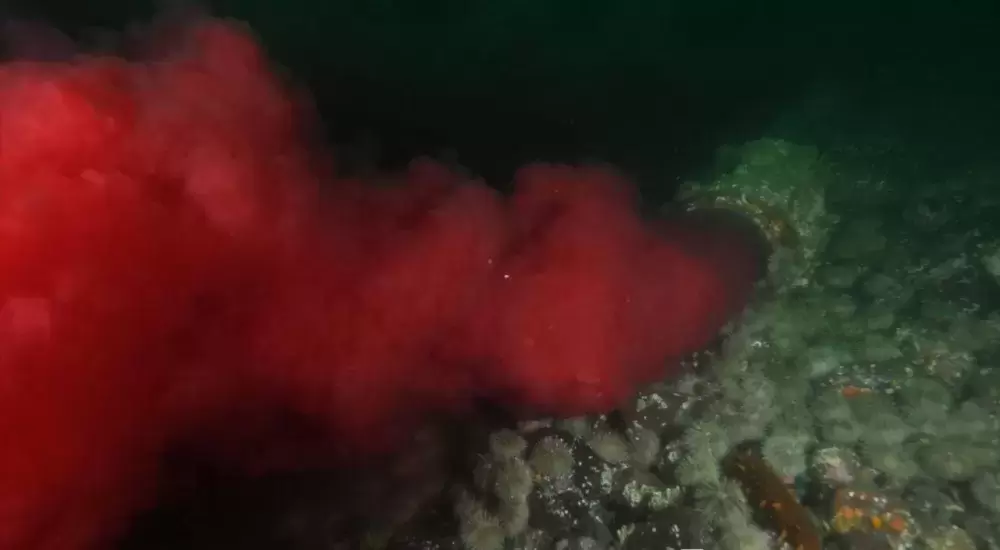Citing concerns over the health of wild salmon, the provincial government has pledged to toughen its requirements for fish processing and aquaculture operations.
In a statement from the Ministry of Environment and Climate Change Strategy released Dec. 20, Minister George Heyman said the processing and fish farming industries will soon face “a comprehensive set of measures.”
“Serious and widespread concerns about effluent from fish processing operations and finfish aquaculture practices have been raised, and the government is taking action,” he said. “We will work with industry, First Nations and local communities to strengthen regulations and make sure any discharge into the water is safe and does not contaminate wild salmon.”
The government’s new focus on monitoring fish plant discharge comes after images of wastewater pouring into the Pacific sparked public uproar in late 2017. In November Tavish Campbell published video of the blood-red wastewater emanating from underwater pipes at Brown’s Bay near Campbell River and by Tofino. The photographer conducted four dives at the Vancouver Island locations in October and November, collecting water samples from the discharge locations.
Campbell sent these samples to the Atlantic Veterinary College for testing, which detected traces piscine reovirus, a disease first discovered on the West Coast in farmed chinook salmon six years ago. The virus is linked to other diseases affecting salmon, including heart and skeletal muscle inflammation.
The Ministry of Environment is currently reviewing the 35 fish processing plants on B.C.’s coast to determine if the effluent is affecting wild salmon. Although fish processors are subject to regulations under B.C.’s Environmental Management Act, the limitations in discharge permits are site specific, depending on the volume and type of effluent from a facility - as well as the conditions of the surrounding environment.
“The purpose of the review is to ensure provincial regulations and permits governing waste discharge from fish processing are informed by the best available science and best practices in other jurisdictions, and fish processing discharge is free of contaminants and pathogens,” stated the ministry.
Compliance officers have been sent to the Tofino and Brown’s Bay locations to ensure the discharge practices follow provincial regulations. Creative Salmon, which farms chinook processed at the Tofino site, stated that effluent from its operation adheres to permits granted by the provincial government.
But this wasn’t enough to ease the concerns of the Tla-o-qui-aht First Nation. Creative Salmon operates in Tla-o-qui-aht hahoulthee, and farms under a protocol agreement with the First Nation. After a meeting with the Tla-o-qui-aht on Dec. 6, Creative Salmon announced it would be immediately reducing the amount of discharge from the Tofino processing plant, with long-term plans to decrease effluent even further and improve wastewater treatment capacity at the plant.
The Ministry of Environment has also pledged to review how sea lice is treated in aquaculture operations to determine if the province’s standards are up to those of other jurisdictions.
“Results from this review will inform potential changes to the Integrated Pest Management Regulation, which regulates sea lice treatment,” stated the ministry.
According a report released by Fisheries and Oceans Canada a year ago, sea lice are the “number one issue” affecting the salmon farming industry worldwide. Salmon farms provide “particularly good conditions for the growth and transmission of sea lice,” stated the DFO study, which focused on aquaculture in the Martimes.
“It’s a typical host-parasite relationship that tends to develop in a farm environment, whether it is terrestrial (land living) or aquatic,” said Dr. Shawn Robinson from the DFO’s St. Andrews Biological Station in New Brunswick. “Like most parasites, sea lice are highly specialized, so when they have easy access to a lot of hosts, they’re capable of reproducing quickly and ensuring their young survive.”
Sea lice feed on the mucous coating a fish, and if prevalent enough can eat away at the skin and blood.
“Based on the frequency of outbreaks over the last two decades, it is apparent that the life cycle of sea lice meshes well into salmon farm conditions,” said Robinson.







